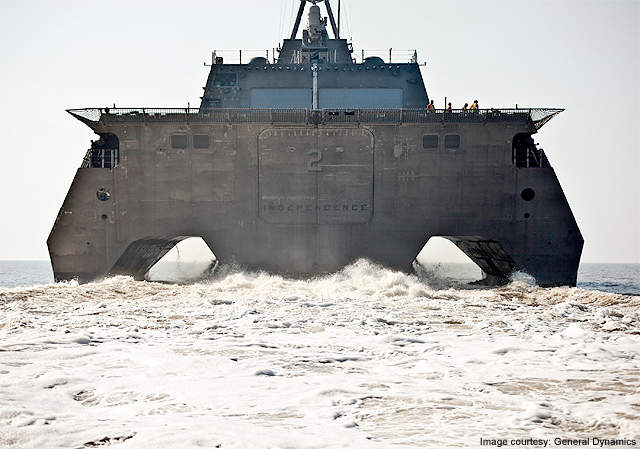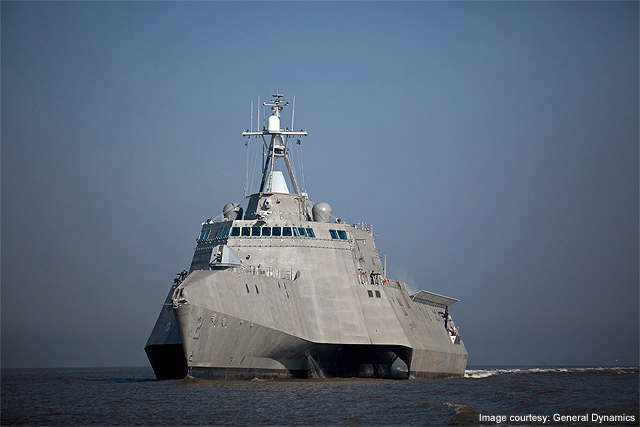The recent visit by USS Canberra to Australia for commissioning was an historic event which captured the attention of Australians, Americans and many others worldwide. However, many people are impressed by the futuristic hull design but know little about the background to the Littoral Combat Ship (LCS) Program, their roles and capabilities. The purpose of this paper is to provide an overview of the two LCS variants which have been under ongoing development since 2004. Much of this overview has been sourced from a February 2022 United States Government Accountability Office, Report to the Committee on Armed Services, House of Representatives (Reference A).
A new family of surface ships, they are fast, highly manoeuvrable, networked surface combatants which were intended to provide increased warfighting flexibility to the Navy fleet and to close gaps in surface, mine, and anti-submarine warfare missions. They are designed to be shallow-draft vessels which operate in the littoral (coastal waters) and counter potential ‘asymmetric’ threats. However, as with any cutting edge design, there have been many challenges for the United States Navy to resolve. This is no surprise when new systems and maintenance programs are developed along with the application of minimum manning and multi crewing arrangements.
In an Australian context the challenges of development, trials and testing, inservice suport and operational capabilities of the Minehunter Inshore (MHI) Project are not dissimilar to those encountered by the USN with the LSC Program. In the case of the MHI which involved new technology its failure to meet performance expectations led to its eventual cancellation in 1991 some fifteen years after the projct commenced. The key issue was severe limitations to its deployability around the Australian coast.
The LCS program has been controversial over the years due to cost growth, design and construction issues with concerns over their survivability (i.e., their ability to withstand battle damage). Additional concerns include; whether they are sufficiently armed and able to perform their stated missions effectively, and concerns over the development and testing of the modular mission packages for LCSs. As a result, the LCS program has been modified or restructured several times over the years, in part to address these issues.
As of 20 July 2023 eleven of the planned fifteen Freedom variant have commissioined and fourteen of the planned seventeen Independence variant have commissioned.
Littoral Combat Ship Designs
The two LCS variants are of quite different designs. Both achieve sprint speeds of over 40 knots and can transit long-range distances of more than 3,500 miles. Designed by Gibbs & Cox the LCS-1 Freedom-class is a high-speed, semi-planing mono-hull. The General Dynamics LCS-2 Independence-class design is a trimaran with a slender stabilised centre hull. The LCS-1 design is built at the Marinette Marine shipyard at Marinette, Wisconsin, with Lockheed as the prime contractor. The LCS-2 design is built at the Austal USA shipyard at Mobile, Alabama, with the Australian owned company Austal USA as the prime contractor.
Missions
Designed to operate in contested littoral waters in conjunction with other Navy forces the LCS’s primary missions are antisubmarine warfare (ASW), mine countermeasures (MCM), and surface warfare (SUW) against small boats (including so-called “swarm boats”), particularly in littoral (i.e., near-shore) waters. To achieve these missions the LCS program includes the development and procurement of ASW, MCM, and SUW modular mission packages which can be transferred between platforms as required. In addition, the LCS are expected to conduct additional missions at any time regardless of its installed mission package. These include; peacetime engagement and partnership-building operations; intelligence, surveillance, and reconnaissance (ISR) operations; maritime security and intercept operations (including anti-piracy operations); support of Marines or special operations forces; and homeland defense operations.
Modular Mission Packages
The allocation of roles to the two LCS variants are as follows; the Freedom variant is dedicated to Surface Warfare and the Independence variant is dedicated to mine countermeasures.
A total of 44 LCS mission packages (10 ASW, 24 MCM, and 10 SUW) were to be procured. These mission packages have been under development since the early days of the LCS program. The Navy’s plan is to develop and deploy initial versions of these packages, followed by development and procurement of more capable versions. The development, testing, and certification of LCS mission packages has been a significant and continuing oversight issue for Congress. A key concern is the fact that to date, few mission modules have been developed, tested, and deployed. Recently, the troubled ASW mission module was cancelled due to cost overruns.
Manning and Deployment
The LCS employs automation to achieve a reduced-sized crew. An LCS with an embarked MCM mission package and an aviation detachment to operate the ship’s embarked aircraft will total about 90 sailors, compared to more than 200 for a Navy frigate and more than 300 for a Navy cruiser or destroyer. In general, most LCSs are to be operated with alternating dual crews so as to increase the percentage of time they can be deployed. LCS operate with two crews (Blue crew and Gold crew) to rotate to the same ship every 4 to 5 months. A ships company is compised of a core 50-person crew with the mission module crew of 20 to create a 70-person crew and another 20 when an avaiation element is embarked.
Another primary challenge is the filling of positions on the LCS. There is a limited number of available sailors trained in skills unique to the LCS who qualify to fill the vacancies. Each crew member on an LCS requires multiple skills and performs multiple functions, such as specific maintenance duties, standing watch, and other tasks associated with a position. For example, an engineer whose primary duty is to operate, service, and repair engines must also have the skill to manage hazardous materials. As a result it is currently a challenge to find replacements.
Planned Maintenance when Deployed
LCS ships are currently overly dependent on contractors to conduct routine maintenance when LCS are deployed. This higher level of overseas travel is due to the ship’s small crew. An effective solution in the form of fly away uniformed maintenance teams is yet to be developed by the US Navy.
Operational and Warfighting Capabilities
The US Navy is yet to fully demonstrate the operational and warfighting capabilities the LCS Fleet needs to perform its missions. In addition, deployed LCS have encountered significant challenges during their deployments that have prevented them from carrying out their operational and warfighting missions. Notwithstanding, a limited number of ships have deployed to Singapore, the Caribbean, and South America. Challenges encountered during these deployments have related to design, navigation, engine propulsion, and other operational issues.
Platform Allocation and Sea Training
In the steady state the USN expects that in addition to Blue and Gold crew rotations ships will be dedicated for training purposes. The plan is to maintain six four-ship divisions of the same variant, including a dedicated training ship to allow off-ship crews to complete training and certification while their ship is deployed.
Plans to Retrofit LCS with Additional Weapons
Another key issue of concern is the retrofitting of LCSs with additional weapons so as to give them capabilities more like those of the Navy Constellation (FFG-62) Class Frigate (formerly FFG(X)). It is understood that Navy has begun a plan to retrofit an Over the Horizon Weapon System on all LCS for increased lethality.
Summary
The US Government Accountability Office’s February 2022 report to Congress states that it found amongst other issues such as budget that,
“The Littoral Combat Ship (LCS) fleet has not demonstrated the operational capabilities it needs to perform its mission. Operational testing has found several significant challenges, including the ship’s ability to defend itself if attacked and failure rates of mission-essential equipment. The Navy is also behind schedule in developing the various mission modules—different configurations of key systems for different missions, such as mine countermeasures for the LCS. In addition, GAO found that the LCS has frequently encountered challenges during deployments. The Navy has begun to take steps to address some of these issues, but it does not have a comprehensive plan to address the various deficiencies identified during testing and deployments. Without a comprehensive plan to address deficiencies, perform adequate testing of the mission modules, and implement lessons learned from completed deployments, the LCS will remain at risk of being unable to operate in its intended environment.”
Whilst this report card does not paint an encouraging future for the LCS it should be remembered that cutting edge concepts and designs are not easy and do take time.
If the US Navy is successful in resolving all issues of concern and satisfies Congress that the LCSs demonstrate the operational capabilities needed to perform their missions the Litoral Combat Ships can expect a service life of twenty years or more.
References:
- United States Government Accountability Office, Report to the Committee on Armed Services, House of Representatives, Littoral Combat Ship, Actions Needed to Address Significant Operational Challenges and Implement Planned Sustainment Approach (GAO-22-105387) dated February 2022
- Congressional Research Service, Navy Littoral Combat Ship (LCS) Program: Background and Issues for Congress, dated 17 December 2019
- United States Government, America’s Navy, Littoral Combat Ship Class
- Lieutenant Anthony Carrillo, U.S. Navy, Time to Scrap LCS, US Naval Institute







